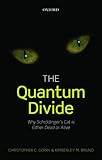The quantum divide : why Schrödinger's cat is either dead or alive / Christopher C. Gerry and Kimberley M. Bruno.
Material type: TextPublisher: Oxford, United Kingdom : Oxford University Press, 2016Copyright date: ©2013Description: vii, 201 pages : illustrations ; 23 cmContent type: text Media type: unmediated Carrier type: volumeISBN: 9780198754077; 0198754078; 9780199666560; 0199666563Subject(s): Quantum theory -- Popular works | Quantum theoryGenre/Form: Popular works.DDC classification: 530.12 LOC classification: QC174.12 | .G475 2016
TextPublisher: Oxford, United Kingdom : Oxford University Press, 2016Copyright date: ©2013Description: vii, 201 pages : illustrations ; 23 cmContent type: text Media type: unmediated Carrier type: volumeISBN: 9780198754077; 0198754078; 9780199666560; 0199666563Subject(s): Quantum theory -- Popular works | Quantum theoryGenre/Form: Popular works.DDC classification: 530.12 LOC classification: QC174.12 | .G475 2016| Item type | Current library | Call number | Copy number | Status | Notes | Date due | Barcode |
|---|---|---|---|---|---|---|---|
 Books
Books
|
Female Library | QC174.12 .G475 2016 (Browse shelf (Opens below)) | 1 | Available | STACKS | 51952000338710 | |
 Books
Books
|
Main Library | QC174.12 .G475 2016 (Browse shelf (Opens below)) | 1 | Available | STACKS | 51952000338703 |
Browsing Main Library shelves Close shelf browser

|

|

|

|

|

|

|
||
| QC174.12 .B83 2016 Bananaworld : quantum mechanics for primates / | QC174.12 .F47 2001 Quantum mechanics : an introduction for device physicists and electrical engineers / | QC174.12 .F53 2016 Quantum physics for beginners / | QC174.12 .G475 2016 The quantum divide : why Schrödinger's cat is either dead or alive / | QC174.12 .G75 2005 Introduction to quantum mechanics / | QC174.12 .S3213 2016 Quantum physics : a first encounter : interference, entanglement, and reality / | QC174.12 .W458 2015 The new quantum age : from Bell's theorem to quantum computation and teleportation / |
"First edition published in 2013; reprinted with corrections 2013"--Title page verso.
Includes bibliographical references (pages 195-196) and index.
Physics fundamentalism -- The duality of particles and waves : the split personality of electrons -- The duality of particles and waves : photons -- More fun with photons : photon-splitting and its uses -- Entanglement and non-locality : spooky actions at a distance -- Quantum information, quantum cryptography, and quantum teleportation -- Schrödinger's cat and Leggett's SQUID : quantum effects on a large scale? -- Quantum philosophy -- Appendix A : a quantum mechanics timeline -- Appendix B : quantum mechanics experiments for undergraduates.
"Using a selection of key experiments performed over the past 30 years or so, The Quantum Divide presents a discussion of the strikingly counter-intuitive phenomena of the quantum world that defy explanation in terms of everyday "common sense" reasoning, and it provides the corresponding quantum mechanical explanations with a very elementary use of associated formalism. Most, but certainly not all, of the experiments it describes are optical experiments involving a very small number of photons (particles of light). The book begins with experiments on the wave-particle duality of electrons, proceed to experiments on the particle nature of light and single photon interference, delayed choice experiments and interaction-free detection, then goes on to experiments involving the interference of two photons, quantum entanglement and Bell's Theorem, quantum teleportation, large-scale quantum effects and the divide between the classical and quantum worlds, addressing the question as to whether or not there is such a divide."--Publisher's description.
1 2

There are no comments on this title.